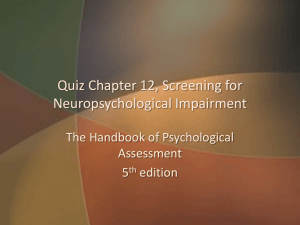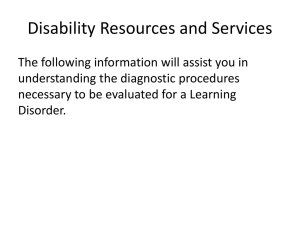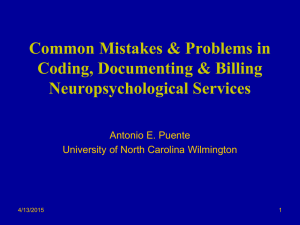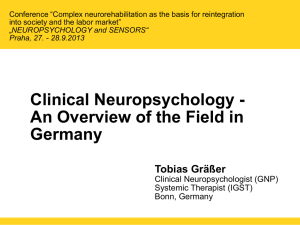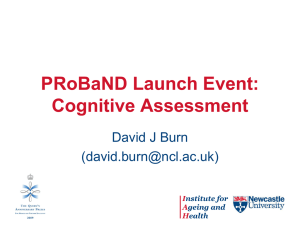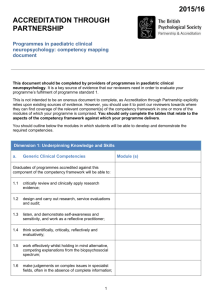Alcohol and Cognition - The Association of Substance Abuse
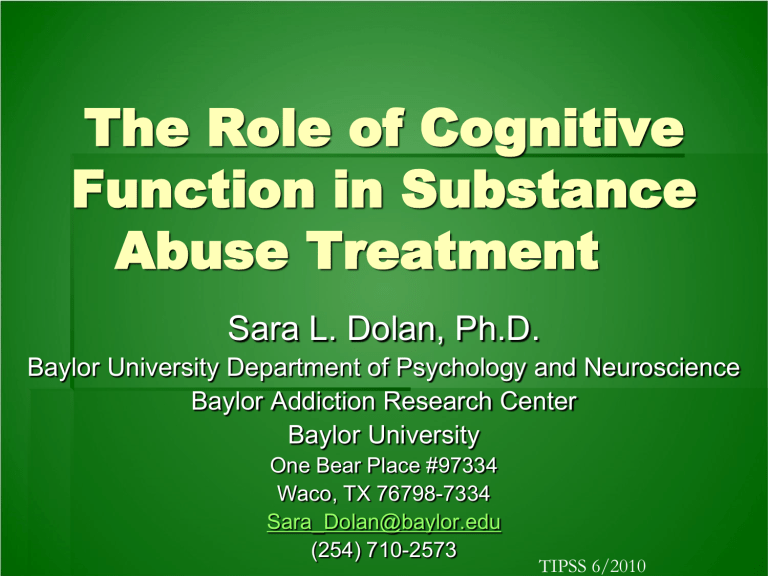
The Role of Cognitive
Function in Substance
Abuse Treatment
Sara L. Dolan, Ph.D.
Baylor University Department of Psychology and Neuroscience
Baylor Addiction Research Center
Baylor University
One Bear Place #97334
Waco, TX 76798-7334
Sara_Dolan@baylor.edu
(254) 710-2573
TIPSS 6/2010
Overview
DSM-IV Alcohol-Related Disorders
History and Background
Review of neuropsychological, neuroimaging, and neuropathological correlates of alcohol related disorders
Review of evidence-based treatments for alcohol dependence
Neuropsychological function and treatment
DSM-IV Alcohol-Related
Disorders - Temporary
Alcohol Intoxication Delirium
Alcohol Withdrawal Delirium (With
Perceptual Disturbances)
DSM-IV Alcohol-Related
Disorders – Persisting
Alcohol-Induced Persisting Dementia
Learning/memory impairment AND 1 +:
Aphasia, Apraxia, Agnosia, Executive dysfunction
Alcohol-Induced Persisting Amnestic
Disorder
Learning/memory impairment (Wernicke-
Korsakoff’s)
Background/History
Beyond thiamine-deficiency (i.e.,
Wernicke – Korsakoff’s), alcoholism researchers have focused on models based on brain systems vulnerabilities
Three predominant theories on the pattern of consequences of alcoholism on the brain
1.
Premature aging / whole brain
2.
Right brain
3.
Frontal lobes
Parsons, Butters, and Nathan, 1987
The Human Brain
Targets of Alcohol and
Other Drugs
Cerebellum
Premature Aging / Whole
Brain
Alcoholism accelerates brain aging
Findings only support premature aging in older alcoholics (i.e., age 50 +)
(Oscar-Berman,
2000)
Alcohol leads to mild generalized dysfunction of the brain
(Parsons, 1996)
Right Brain
Right hemisphere is more vulnerable to the effects of alcoholism than the left hemisphere
Impairments in visuospatial functioning and emotional processing
(Oscar-Berman, 2000)
Emotional processing deficits also may be due to abnormalities in other brain regions
(e.g., limbic system, frontal lobes;
Colson & Dolan,
2010; Oscar-Berman & Schendan, 2000
)
Frontal Lobes
Frontal lobes show increased susceptibility to alcoholism-related damage
Evidence from post-mortem neuropathological studies
(Harper, 1998) and neuroimaging of living patients
(Sullivan, 2000)
Also behavioral and neuropsychological deficits in executive functioning seem to be prominent in both currently-drinking and recently-detoxified alcoholics
(e.g., Bechara et al.,
2001)
Neuropsychological
Impairment in Substance
Abusers
Approximately 33-75% of patients admitted to VA outpatient substance abuse treatment programs have measurable cognitive impairment
Mostly in the mild to moderate range
( Eckardt & Martin, 1986; Meek et al., 1989; Parsons & Leber, 1981; Tabakoff & Petersen,
1988 )
Neuropsychological Deficits in Substance Abusers
Alcoholics have deficits in:
Memory (anterograde worse than retrograde)
Visual worse than verbal
Visuospatial functions
Executive functions
Problem-solving, abstraction
Cognitive efficiency
( Page, 1983; Page, 1987; Parsons et al., 1987;
Ratti et al., 2002; Wilson, 1987 )
Executive Function
A disruption of processes thought to:
Monitor
Direct
Organize
Regulate behavior…
…to enable persons effectively to achieve desired goals while minimizing adverse consequences
Mediated by the prefrontal cortex
( Lezak, 1995 )
Neuropsychological
Functioning
Early studies suggested that sober alcoholics demonstrate impairment on neuropsychological tests that is similar to that of patients with diagnosed mild-to-moderate brain injury
(Parsons, 1986).
Neuropsychological
Functioning
15 studies examining performance between alcoholic patients and control peers revealed poorer performance on a variety of tests
(Parsons & Farr, 1981)
Neuropsychological
Findings
Compromised fronto-cortico-cerebellar circuits underlie cognitive deficits
(Scheurich, 2005)
Patterns of correlations between cortical and subcortical volume deficits
To compensate for deficient task performance, alcohol-dependent patients require the use of additional and higher-order executive functions
(Scheurich, 2005)
Structural Neuroimaging
In recently detoxified alcoholics, CT findings show widened sulci, ventricular dilation, and cerebellar atrophy
(Grant, 1987)
MRI: Reductions in cortical and subcortical gray and white matter
(Jernigan et al, 1992; Schmidt et al.,
2005)
Reduction in brain weight and volume associated with reduction in white matter volume
(Harper et al., 2003)
Reduction in total hippocampus volume
(Arciniegas et al., 2006)
Functional Neuroimaging
Functional MRI studies:
Decreased prefrontal cortical function in chronic substance abusers (for a review, see London et al.,
2000 )
Additional recruitment of brain areas ( Scheurich,
2005 )
Cerebral glucose metabolism (PET studies):
Decreased regional cerebral blood flow to frontal regions, ranging from a 75% ( Nicolas et al., 1993 ) to
86% ( Erbas et al., 1992 ) reduction in chronic alcoholics
SPECT: decreased blood flow in frontal lobes and cerebellum (latter appears to persist even after a period of abstinence)
Functional Brain Changes in Problem Drinkers
Etiology of Progressive Cognitive
Decline
Wernicke’s Encephalopathy (B1 deficiency)
Characterized by nystagmus, abducens and conjugate gaze palsies, ataxia, and mental disturbance (confusional state)
Etiology of Progressive
Cognitive Decline
Wernicke-Korsakoff Syndrome (aka
Korsakoff psychosis or Korsakoff amnesic state; DSM-IV=Alcohol-Induced
Persisting Amnestic Disorder)
Retentive memory impaired out of proportion to other cognitive functions (chronic manifestation of Wernicke disease)
With treatment, recovery occurs in less than 20% of patients
Alcohol and Dementia
Association between alcohol use (especially heavy use or dependence) and the development of dementia
(Oslin et al., 1998)
Heavy alcohol use contributes to the emergence of dementia in more than 20% of patients diagnosed with dementia (cited in Kapaki et al., 2005)
May be most apparent among men and those with
ApoE4 allele (Mukamal et al., 2003)
Cortical and subcortical pathology (Schmidt et al, 2005)
Reversibility
Recovery of function is supported in the neuropsychological and neuroradiological literature
(Grant, 1987)
Some studies report only partial recovery
(Oslin & Cary, 2003)
Reversibility
Cognitive functioning improves with extended abstinence
Much improvement over first 21-30 days of abstinence
Can take as long as 1 year
How does recovery occur?
Glial regeneration
Synaptic plasticity
Range of Impairment
No Impairment Mild Moderate Severe
Mild (subtle) = may or may not evidence impairment in daily life
“Social” drinkers (6+ drinks per day;
Parsons, 1998
)
Moderate = more likely show some impairment in daily life
Severe = Wernicke’s Encephalopathy (acute),
Korsakoff’s Disease, Alcohol-Induced Persisting
Dementia (chronic)
Prevalence of Impairment
33 – 75% of alcoholics entering treatment display neuropsychological deficits, most in the mild to moderate range
Problem-solving
Abstract thinking
Concept shifting
Learning / Memory
Eckardt & Martin, 1986; Meek et al., 1989; Parsons & Leber, 1981; Tabakoff & Petersen, 1988
Prevalence of Impairment
Categories = 50%
Abstract thinking
COWA = 50%
Verbal fluency
Trails-B = 17%
Cognitive flexibility
Stroop = 12%
Response inhibition
Shipley Vocabulary = 13%
Verbal skills
Morgenstern & Bates, 1999
Specific Neuropsychological
Deficits and Substance Abuse
Treatment Process
Attention / Learning / Memory
Patients can’t learn or remember new skills taught in treatment (Sanchez-Craig & Walker,
1982)
Specific Neuropsychological
Deficits and Substance Abuse
Treatment Process
Executive function – patients can’t apply new skills after treatment
(Morgenstern & Bates, 1999)
Abstract thinking
Generalizability of skills outside of treatment
Cognitive flexibility
Switching tracks
Verbal Fluency
Producing alternative strategies
Response Inhibition
Inhibiting pre-potent responses
Neuropsychological Deficits and
Substance Abuse Treatment
Process
Failure to acquire strategies taught during treatment
The cognitive and behavioral strategies taught in treatment may be less effective in preventing relapse
Impaired individuals have different change processes than unimpaired individuals
Block, Bates, & Hall, 2003; Morgenstern & Bates, 1999
Neuropsychological Function and Treatment Process /
Outcome
Clinicians’ misattributions of patients’ behaviors
Verbal skills (previously learned information) remain relatively preserved, so patients appear unimpaired
Clinicians fail to identify cognitive impairment in at least 40% of patients
( Fals-
Stewart et al., 1993; 1994 )
Neuropsychological dysfunction may result in more rule violations in treatment
( Fals-Stewart et al., 1994 )
Treatment
Evidence-Based
Treatments
Cognitive-Behavioral
Motivational Enhancement (MI)
Twelve Step Facilitation
Community Reinforcement
CRAFT
Behavioral Couples Therapy
Cognitive-Behavioral
Change thoughts, feelings, and behaviors associated with addiction
Relapse-Prevention Coping Skills
Training
Communication Skills Training
Cue Exposure Treatment
Motivational Enhancement
Increase self-directed motivation to change
Increase self-efficacy for change
Be non-confrontational
Twelve Step
AA/NA/CA
Emergency planning
Sober social support
Common Themes
• Empirically-supported psychosocial treatments for SUDs
(Finney, Willbourne, and Moos,
2007)
:
– Enhance/maintain motivation to change.
– Involve teaching/learning of coping skills.
– Restructure the social environment.
– Can involve conditioning-based interventions.
– Change perceptions of social norms.
– Enhance self-efficacy for robust behavioral change.
Participants
187 Alcohol-Dependent patients in residential treatment
Clinical trial of naltrexone and coping skills training
31% female
39.0 ± 9.4 years of age
13.4 ± 2.3 years of education
66.1 ± 28.3 % alcohol use days during the 6 months pre-treatment
Measures
Urge-Specific Strategies (USS; 6 mo.
α = .91; 12 mo. α = .90)
21 situation-specific strategies taught in cue exposure, communication skills, or relaxation/meditation
General Strategies for Alcoholics (GSA; 6 mo. α = .92; 12 mo. α = .90)
21-item lifestyle change strategies taught in communication skills and in the general treatment program
Design
6 and 12 mos post-Tx:
1.USS
2.GSA
3.Measure of substance use
6 months 12 months
Sample size n = 131 n = 117
Relapse rate 55% 70%
USS - Cognitive
Positive consequence
Negative consequence
Mastery messages
Distracting thoughts
Challenge the thoughts
Think about treatment
Months 4-6 Months 7-12 Months 4-6 Months 7-12
Lapse Lapse pr pr
**
**
** ns
* ns
**
**
*
**
*
*
-.47**
-.31*
-.42**
-.26*
-.24*
-.13
-.29*
-.15
-.27*
-.37**
-.32**
-.28*
*p < .01; **p < .001
USS – Cognitive, Behavioral
Alternative behavior
Solve the problem
Think through behavior chain
Refuse the drink
Months 4-6 Months 7-12 Months 4-6 Months 7-12
Lapse Lapse pr pr
** ** -.33** -.33**
*
**
**
**
-.30*
-.21
-.34**
-.37**
** * -.21
-.35**
*p < .01; **p < .001
USS – Behavioral, Other
Escape
Delay, wait it out
Other social support
Spiritual coping
Months 4-6 Months 7-12 Months 4-6 Months 7-12
Lapse Lapse pr pr ns * -.25* -.32* ns
**
*
*
*
*
-.25*
-.21
-.21
-.23
-.31*
-.15
*p < .01; **p < .001
GSA - Cognitive
Positive consequence
Months 4-6 Months 7-12 Months 4-6 Months 7-12
Lapse
**
Lapse
** pr
-.50** pr
-.46**
Remind self sober
Challenge thoughts
**
*
**
**
-.43**
-.34**
-.49**
-.41**
Negative consequence
Think about treatment
Spiritual focus
*
*
* ns
**
*
-.27*
-.25*
-.25*
-.24*
-.30**
-.21
*p < .01; **p < .001
GSA - Behavioral
Sober good time
Work toward future goals
Other social support
Work on problems regularly
Tell others sober
Months 4-6 Months 7-12 Months 4-6 Months 7-12
Lapse
**
**
Lapse
**
** pr
-.47**
-.40** pr
-.49**
-.45**
**
**
**
*
*
*
-.36**
-.30*
-.29*
-.26*
-.18
-.17
*p < .01; **p < .001
GSA – Behavioral, Other
Keep busy
Eat, sleep, healthy behavior
Talk over feelings
Avoid tempting situations
Relax or meditate regularly
Months 4-6 Months 7-12 Months 4-6 Months 7-12
Lapse Lapse pr pr ns ns
*
*
-.40**
-.39**
-.39**
-.30**
** ns ns ns
-.31**
-.27*
-.25*
-.32**
* ns -.16
-.26*
*p < .01; **p < .001
Summary
Top 5 situation-specific coping strategies
Positive consequence thoughts, mastery messages, alternative behaviors, problem solving, think through a behavior chain
Top 5 general lifestyle coping strategies
Positive consequence thoughts, remind self that you are sober, challenge thoughts about drinking, sober good time, work toward future goals
Conclusions
Improve treatment by:
Teaching situation-specific AND general lifestyle coping skills
Emphasizing strategies that are more effective
Eliminating skills that are ineffective
( Dolan et al., in preparation )
Hypothetical Patient
Bill is a 50 year-old male veteran who presents for treatment of his “excessive drinking”
Self-reported alcohol consumption escalated to a fifth of vodka per night for
7 months, following his divorce
Hypothetical Patient cont
He has started getting into trouble at work, and his grown children “don’t seem to know who he is anymore” because of his behavior
He used to be a very organized person and now his apartment is a mess and he isn’t able to get his bills paid correctly
Hypothetical Patient cont
He successfully completes detox
On Day 1 of Intensive Outpatient
Treatment, he appears to have some difficulty comprehending the structure of the treatment program, and he asks repetitive questions
Hypothetical Patient cont
A neuropsychological evaluation reveals that he has memory and executive dysfunction
Very typical profile for alcohol-related neuropsychological dysfunction
What do we do to maximize treatment benefit for this patient?
Factors that Might Influence
Treatment Outcome
Treatment-specific variables
Length and type of treatment
Individual differences
Severity of dependence
Presence of comorbid psychiatric disorders
Personality factors
Anger level
( Project MATCH, 1997 )
Patient-Treatment
Matching
Comorbidity
Mood, anxiety disorders
PTSD
Medical conditions
Factors that May Influence
Treatment Outcome
What about neuropsychological function?
Do these patients have the cognitive capacity to participate in treatment aimed at changing thoughts and behaviors related to their substance use disorder?
I.e., Are their brains intact enough to learn, process, and apply new relapse-prevention skills?
Methods
Participants
Substance dependent individuals (n=20) from a local state-funded residential treatment program
Clean for > 21 days
Procedures
Diagnostic interview (r/o psychotic disorder)
Questionnaires
Neuropsychological battery
Coping Skills assessment
57
Neuropsychological
Battery
Baseline IQ
Verbal learning, memory
WAIS-III
Attention, working memory
Speeded information processing
Visuospatial functioning
58
Block Design
(visuospatial function)
59
Neuropsychological
Battery (con’t)
Executive functioning
Wisconsin Card Sorting Test (Set-shifting, working memory, responsiveness to feedback, cognitive flexibility)
Trailmaking Test A&B (Visual scanning, attention, cognitive flexibility)
Controlled Oral Word Association (verbal fluency)
Stroop Color Word Test
60
Trail Making Test Part B
Wisconsin Card Sorting Test
Stroop Color Word Test
63
Results
64
Results – Coping Skills
65
Results – Relationship
Between Coping Skills and
NP Measures
66
Results – NP Impairment
Status
67
Study #2
More fine-grained analysis of executive functioning
N=49
Neuropsychological Battery:
Verbal Fluency
Trailmaking Test
Wisconsin Card Sorting Test
Color-Word Interference (Stroop)
Iowa Gambling Task
Tower of Hanoi
68
Iowa Gambling Task
69
Tower of Hanoi
70
Demographics
Age
Gender
Education
Daily Alcohol Intake
Mean / Frequency
32.06
46% M
12.17
7.23
Prior Treatment Attempts 2.33
Sobriety Length
Contemplation Ladder
54.53
9.21
SETOT
SOTOT
88.44
87.24
VF 9.4
VF Letter vs. Category 9.3
SD
10.01
2.03
23.97
2.89
53.71
1.75
35.19
32.14
3.4
3.0
71
Verbal Fluency and Coping
Skills
VF - Letter
VF – Letter vs.
Category
SETOT SOTOT
-.25*
-.33**
-.30**
-.31**
Number of
USC-E skills >4
-.24*
-.23*
GETOT ns
-.25*
GOTOT ns
-.27*
72
Clinical Implications
Patient – Treatment Matching
Pre-treatment neuropsychological assessment
Target skills to individual patient’s neuropsych profile
Reduction in number of skills taught in CBT
Behavioral possibly better than cognitive focus
Extensive repetition
Extra role-plays
Cognitive Rehabilitation
A la TBI, schizophrenia
73
Cognitive Rehabilitation
Computer-assisted cognitive stimulation exercises may increase speed of cognitive recovery
(Grohman et al., 2003)
This may then improve treatment process and outcome
However, time- and cost-intensive
Acknowledgements
Grant Support
Baylor University
Research Committee
NIAAA T32 (Brown
University; mentors:
Damaris Rohsenow,
Ph.D. and Paul Malloy,
Ph.D.)
Students
Graduate: Robyn
Baldridge, Sarah
Martindale, Laura Sejud,
Sean McGowan, Anthony
Giardina
Undergraduate: Sanja
Trtanj
75

